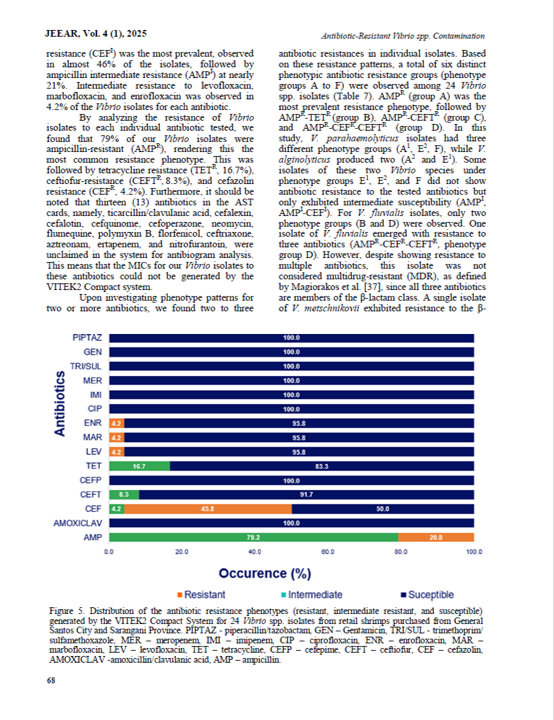Prevalence and Antibiotic Resistance Patterns of Vibrio spp. in Assorted Retail Shrimp Products Sold in General Santos City and Sarangani Province
Abstract
Antimicrobial resistance (AMR) in the farm-to-fork chain is a pressing public health threat, particularly in aquaculture, where antibiotics are used to boost production. Owing to the high consumption of shrimp in the Philippines, AMR in this economically important aquaculture product is of special concern. However, the risks of antibiotic-resistant bacterial contamination are poorly understood in key production areas, requiring urgent attention to protect public health. To address this concern, this study investigated the occurrence of antibiotic-resistant Vibrio in various shrimp products sold by retail vendors in two major shrimp production areas (Sarangani Province and General Santos City). From 35 shrimp samples purchased from ambulant and permanent retail stores, a total of 60 isolates were generated, of which 24 were identified via the VITEK 2 Compact System Gram-negative identification protocol as V. parahaemolyticus (n = 10), V. fluvialis (n = 5), V. alginolyticus (n = 8), and V. metschnikovii (n =1). Moreover, while several Vibrio isolates had resistance to one or two antibiotics, no isolate manifested multidrug resistance. The predominant resistance phenotype was AmpR (ampicillin resistant; 54.2%), followed by AmpR-TetR (ampicillin-tetracycline resistant; 16.7%), AmpR-CeftR (ampicillin-ceftiofur resistant; 4.2%), and AmpR-CefR-CeftR (ampicillin-cefazolin-ceftiofur resistant; 4.2%). In addition, we recovered other potentially pathogenic isolates from the shrimp samples, such as Aeromonas spp., Chromobacterium violaceum, Sphingomonas paucimobilis, Shewanella putrefaciens, Pseudomonas stutzeri, Photobacterium damselae, and Acinobacter haemolyticus. Our findings raise concerns about the high incidence of ampicillin resistance among Vibrio isolates, which can lead to the development of antibiotic resistance among pathogens infecting cultured shrimps and human consumers. This underscores the need for continuous surveillance of antimicrobial usage in shrimp aquaculture to mitigate the spread of AMR and improve food safety controls, protecting consumers from the transfer of antibiotic-resistant Vibrio spp. through the food chain.

